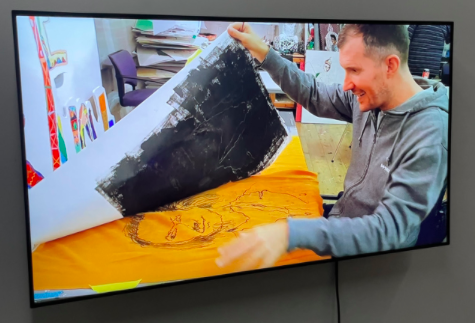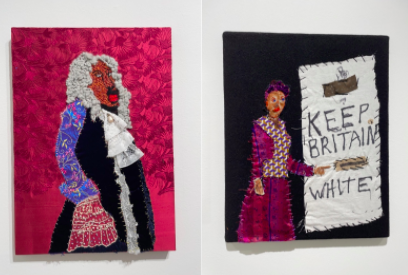‘Common Threads’ @ Autograph Hackney
Autograph Gallery in Hackney reopened for the summer with Common Threads, an exhibition highlighting identity and neurodiversity. Since 1989, Autograph has championed photography that explores issues of race, human rights, social justice. The gallery aims to highlight diversity in the visual arts, and this exhibition, Common Threads, did just that. Its curators, Michelle Carlile, Ali Eisa and Lucy Keany, sought to create space for survivors of brain injuries and encourage the public to explore disability in contemporary art, and by extension, contemporary life.
Common Threads featured works by a collective of self-taught artists known as Submit to Love Studios. The Studio is made up entirely of brain injury survivors. Speaking on his identity as an artist, collective-member Affiong Day says ‘losing your abilities takes away your identity, but it also takes away ego … I do art because I can, and because it’s something I don’t mind failing at.’
Twenty-three Submit to Love members participated in Common Threads, and in keeping with the studio’s collective ethos, many of the works were collaborative. In the past, the studio has produced pieces that saw as many as fifty hands, with no one person’s contribution dominant. The process of sharing – sharing an identity as a brain injury survivor, sharing skills, sharing the sharing the finished work - is central.
Submit to Love used Autograph’s own extensive collection of photography as inspiration for textile works. They reimagined Autograph’s historical photographs as embroideries, appliqué and fabric prints. For many of the artists, it was their first time using these mediums.
Posy Dixon, Common Threads Introduction Video, 2020.
Before entering the main exhibition space, viewers encountered a short film by Posy Dixon. The video shows the collective at work, making the very same pieces the visitor is about to experience. The folksy, upbeat film fades from clip to clip of the artists in their creative process. The video contextualises the art, providing a real sense of who the artists are. Visitors see the studio space, watch the artists’ hands paint, weave and fold. Visitors listen to the artists’ voices and laughs, creating a fully immersive experience. About halfway through, a narrator asks why the artists chose certain photographs as inspiration. The answers are refreshingly honest: one artist laughs and admits they chose it because it was ‘easy’. Another says they simply ‘like the different style.’ The artists are truthful and unpretentious.
Common Threads Exhibition Space at Autograph.
Upon entering the main exhibition space, visitors encountered a small, square room with evenly spaced art hung at eye level. The white walls of the space worked well as a background, letting the tactility and bright hues of the art take centre stage. Even here, the artist’s voices from the corridor’s introduction video fill the space, reminding the visitor of the living and breathing people who made the art. Their experience of creating is centred and impossible to ignore.
Sean Jevon, Inspired by a Yinka Shonibare Portrait, 2020, applique on silk, 70 x 50 cm (Left) and Chris Miller, Untitled, 2020, applique with an extract from a conversation between Chris Miller and Ali Eisa, 51 x 41 cm (Right).
According to Autograph, Common Threads ‘explores ideas of heritage, talent and otherness – and the many ways underrepresented stories can be told.’ The exhibition did not shy away from difficult subjects. The artists’ disability is not ignored nor glamourised. And the art is intersectional, tackling the crossroads of disability with race, sex, and gender. Some works directly call out systemic issues in Britain. Yet, the heavy subjects are treated unusually lightly. The serious subjects are counterbalanced by bright pops of pinks and lace ruffles. The art is a joy to witness – full of texture and colour. It is clear the artists enjoyed the artistic process of creation. The Studio describes the act of making art as a discovery, saying that by creating an artist discovers ‘new gifts, new culture, new connection, new identity.’ With this in mind, it is perhaps less surprising that many of the artists had never used textile mediums before Common Threads.
Portraits of the Submit to Love Collective by Leon Foggit.
In addition to the textile pieces, visitors will see photographs of the artists involved, taken by photographer Leon Foggit. Along with the videos, these portraits, once again, serve to centre the collective and their experience.
Studio Collaboration, The Couple. 2020, Applique, 102 x 76 cm.
In sum, Common Threads highlighted a side of London’s visual arts scene rarely seen or discussed in the wider media – that of disability. The lived experience of brain trauma shimmers underneath the beautiful textiles. Neither overly curated, nor glamourised, Common Threads is a unique exhibition that excels in its honesty.
Common Threads was on show from June 23rd until August 14th, but is still accessible via Autograph’s website.
Amanda Andrade
Editor of Emerging Artists, MADE IN BED






